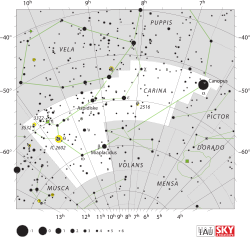Omega Carinae

Location of ω Carinae (circled) | |
| Observation data Epoch J2000 Equinox J2000 | |
|---|---|
| Constellation | Carina |
| Right ascension | 10h 13m 44.21739s[1] |
| Declination | –70° 02′ 16.4563″[1] |
| Apparent magnitude (V) | 3.29[2] |
| Characteristics | |
| Spectral type | B8 IIIe[3] |
| U−B color index | –0.285[4] |
| B−V color index | –0.083[4] |
| Astrometry | |
| Radial velocity (Rv) | +7.0[2] km/s |
| Proper motion (μ) | RA: -36.01[1] mas/yr Dec.: +7.09[1] mas/yr |
| Parallax (π) | 9.54 ± 0.09[1] mas |
| Distance | 342 ± 3 ly (104.8 ± 1.0 pc) |
| Details | |
| Surface gravity (log g) | 3.581[5] cgs |
| Temperature | 13,275[5] K |
| Rotational velocity (v sin i) | 245[5] km/s |
| Other designations | |
Omega Carinae (ω Car, ω Carinae) is a star in the constellation Carina. With a declination greater than 70 degrees south of the celestial equator, it is the most southerly of the bright stars of Carina (third-magnitude or brighter), and it is part of a southern asterism known as the Diamond Cross. This star has an apparent visual magnitude of 3.3[2] and is located at a distance of about 342 light-years (105 parsecs) from Earth.[1]
Properties
Omega Carinae has a stellar classification of B8 IIIe,[3] which places it among a category known as Be stars that display emission lines of hydrogen their spectrum. Omega Carinae is a shell star,[3] having a circumstellar disk of gas surrounding its equator. The luminosity class of III indicates it has evolved into a giant star, having exhausted the hydrogen at its core and left the main sequence. The effective temperature of 13,275 K[5] in its outer envelope is what gives this star the blue-white hue that is characteristic of B-type stars.
This star is rotating rapidly with a projected rotational velocity of 245 km s–1, which gives a lower limit to the star's azimuthal velocity along the equator. The critical equatorial velocity, at which the star would begin to break up, is 320 km s–1. The star's axis of rotation is inclined by an estimated angle of 70.8° to the line of sight from the Earth.[5]
In culture
In Chinese, 南船 (Nán Chuán), meaning Southern Boat, refers to an asterism consisting of ω Carinae, V337 Carinae, PP Carinae, θ Carinae and β Carinae .[7] Consequently, ω Carinae itself is known as 南船四 (Nán Chuán sì, English: the Fourth Star of Southern Boat.)[8]
Rarely, this star is called by the name Simiram.[citation needed]
References
- ↑ 1.0 1.1 1.2 1.3 1.4 1.5 van Leeuwen, F. (November 2007), "Validation of the new Hipparcos reduction", Astronomy and Astrophysics 474 (2): 653–664, arXiv:0708.1752, Bibcode:2007A&A...474..653V, doi:10.1051/0004-6361:20078357
- ↑ 2.0 2.1 2.2 Wielen, R. et al. (1999), Sixth Catalogue of Fundamental Stars (FK6). Part I. Basic fundamental stars with direct solutions (35), Astronomisches Rechen-Institut Heidelberg, Bibcode:1999VeARI..35....1W
- ↑ 3.0 3.1 3.2 Rivinius, Th.; Štefl, S.; Baade, D. (November 2006), "Bright Be-shell stars", Astronomy and Astrophysics 459 (1): 137–145, Bibcode:2006A&A...459..137R, doi:10.1051/0004-6361:20053008
- ↑ 4.0 4.1 Gutierrez-Moreno, Adelina; Moreno, Hugo (June 1968), "A photometric investigation of the Scorpio-Centaurus association", Astrophysical Journal Supplement 15: 459, Bibcode:1968ApJS...15..459G, doi:10.1086/190168
- ↑ 5.0 5.1 5.2 5.3 5.4 Frémat, Y. et al. (September 2005), "Effects of gravitational darkening on the determination of fundamental parameters in fast-rotating B-type stars", Astronomy and Astrophysics 440 (1): 305–320, arXiv:astro-ph/0503381, Bibcode:2005A&A...440..305F, doi:10.1051/0004-6361:20042229
- ↑ "ome Car -- Be Star", SIMBAD (Centre de Données astronomiques de Strasbourg), retrieved 2012-01-13
- ↑ (Chinese) 中國星座神話, written by 陳久金. Published by 台灣書房出版有限公司, 2005, ISBN 978-986-7332-25-7.
- ↑ (Chinese) AEEA (Activities of Exhibition and Education in Astronomy) 天文教育資訊網 2006 年 7 月 28 日
External links
| ||||||||||||||||||||